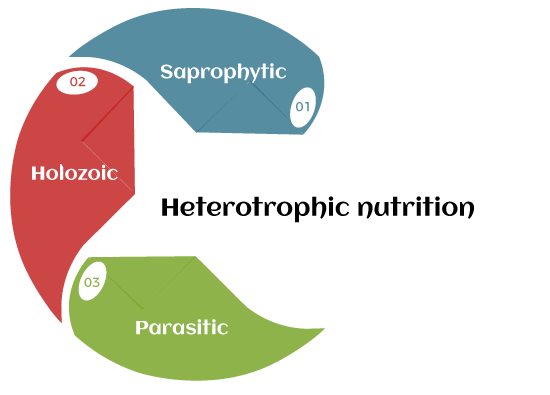Types of Heterotrophic NutritionAll primates and non-photosynthetic plants are classed as heterotrophs since they are unable to create food. As a corollary, these creatures seek alternative food sources. Autotrophs are the principal consumers in a food chain, while heterotrophs are typically secondary or tertiary. Heterotrophic organisms are unable to produce their food, thus they must rely on other sources of nourishment, particularly plant and animal debris. Heterotrophs comprise all animals and non-photosynthetic plants since they are unable to prepare food. Humans and other creatures transform organic, solid, or liquid food into energy. Fungi, for illustration, depends on the decomposition of organic material to provide sustenance. Heterotrophs, in particular, break down intricate foods into simple components that can be digested. Various forms of heterotrophic nourishment may be found in nature. Here are some major types of heterotrophic nutrition.

1. Holozoic NutritionThe intake and internal digestion of solid and liquefied foodstuff in an entity are referred to as holozoic nutrition. Ingestion, digestion, absorption, assimilation, and elimination are all included in this process. Ingestion is the procedure of escorting in food, which is then broken down into simple organic materials through digestion. The undesirable and undigested particles are expelled after the helpful components have been extracted. All vertebrates are examples of creatures that have holozoic nutrition. Holozoic feeding is also seen in certain unicellular species, such as amoeba. Types of Holozoic OrganismsThere are three types of holozoic organisms:
2. Saprophytic NutritionSaprophytes (animals that eat dead and decaying creatures) get their energy from dead and decayed organisms. They are an important element of the ecosystem because they assist to maintain our environment clean by recycling nutrients. Fungi and certain kinds of bacteria are examples of saprophytes. These are also responsible for the deterioration of bread and other comparable foods. Saprophytes secrete enzymes that work on the organic matter's complexity. It works by dissolving it into its elements, which they may readily swallow. 3. Parasitic NutritionParasites are parasitic animals that live in or on other species and feed on their hosts. The majority of parasitic organisms are damaging to the hosts' health and can even kill them in rare instances. Animals and plants may both act as hosts. The parasite, dissimilar to commensalism, grounds a bit detriment to its host. The louse on a human head, the Cuscuta plant, and tapeworms are all parasites. The parasite Cymothoa exigua is rare. It's also known as the tongue-eating louse, and it gets its name from the fact that it lives in the mouth of the Lithognathus marine fish. It ultimately shuts off the fish's tongue's blood supply, causing it to collapse off. The louse then latches itself to the fish's tongue remnants and acts as a substitution.
Next TopicExamples of Heterotrophic Nutrition
|
 For Videos Join Our Youtube Channel: Join Now
For Videos Join Our Youtube Channel: Join Now
Feedback
- Send your Feedback to [email protected]
Help Others, Please Share










